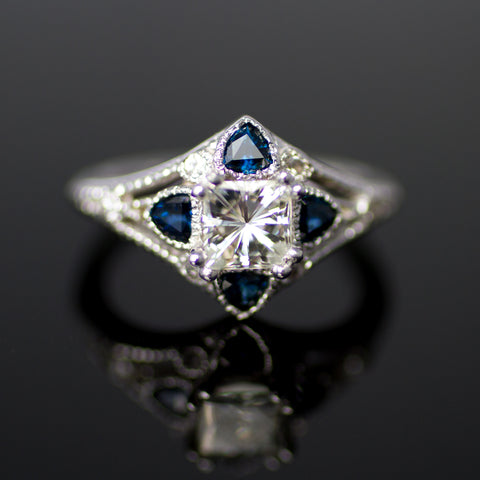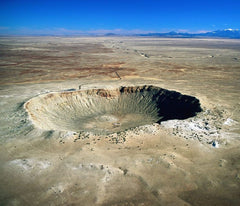Your Cart is Empty
FREE SHIPPING ON ALL DOMESTIC ORDERS
Diamonds have been the gold standard for engagement rings for over 60 years. They're the hardest of all known natural gemstones and have a brilliance and radiance that dazzle the eye. But if you think they're the only stone worthy of proposing with, then you need to read this brief overview. Moissanites and White Sapphires are some great alternatives to consider. They're affordable, eco-friendly, durable, and make no mistake, absolutely stunning.
If diamonds are "a girl's best friend", then moissanites and white sapphires are like those cool new people who just moved to town you want to get to know. The following comparison will help you understand the basic differences between diamonds, moissanites, and white sapphires.
To many people, diamonds are the ultimate gemstones. From their durability to their stunning radiance, they're the most popular choice for engagement ring center stones. They're also the most expensive.
| Chemical Compound | Carbon |
| Hardness (Mohs Scale) | 10 |
| Color | A colorless or near colorless diamond will be very white but can still show very subtle tints of yellow or brown. |
| Brilliance | A well cut diamond will disperse light exceptionally. Nothing sparkles quite like a diamond. Its luster, transparency, brilliance, fire, and scintillation are superb. |
| Price | $$$ |
Diamonds are the hardest known minerals and have a 10 rating on the Mohs Scale of Hardness. This means they are incredibly resistant to scratches. Note: this does not mean that they're indestructible. In fact, diamonds are vulnerable to chipping. Even though this is rare, diamonds still require proper care and maintenance.
Moissanite is an excellent alternative to diamond. They have a very impressive look--most would easily confuse it for a diamond.

The Compass ring with a moissanite center stone.
 Moissanite is actually a natural compound that is so rare, it's almost only found in meteorites. It was discovered in 1893 by Henri Moissan in 1893 while examining rock samples from the Arizona Meteor Crater. For jewelry purposes, it's synthetically created in controlled environments.
Moissanite is actually a natural compound that is so rare, it's almost only found in meteorites. It was discovered in 1893 by Henri Moissan in 1893 while examining rock samples from the Arizona Meteor Crater. For jewelry purposes, it's synthetically created in controlled environments.
| Chemical Compound | Silicon Carbide |
| Hardness (Mohs Scale) | 9.25 - 9.5 |
| Color | Colorless moissanites may show up yellowish under certain lighting. |
| Brilliance | Moissanites have a higher refractive index than a diamond, producing a wonderful, shiny sparkle. Their unique faceting pattern often form a distinct rainbow flash effect that some people love. |
| Price | $$ |
Can you tell a difference between moissanite and diamond?
In my experience, when people see a moissanite ring they think it's a gorgeous diamond. Moissanite is very white and has an eye-catching sparkle. It's also a great choice if you're concerned about the ecological or ethical issues surrounding diamond mining. And since it costs a fraction of what a diamond costs, there's really no reason not to consider it.
Some people can't get past the feeling that moissanite is a "fake diamond". My advice is that if you love its look, don't think to pass it off as a diamond, but embrace it for its own unique strengths. Moissanites have a great story behind them and represent a progressive approach towards what an engagement ring should mean.
On the flip side, if having a natural stone is important to you, then take a look at our next diamond alternative, white sapphire.
White Sapphire is gaining popularity as a diamond alternative for many reasons. Like diamonds, white sapphires are natural, rare, valuable gems. Unlike diamonds, white sapphires are much less expensive while still providing an acceptable shine and sparkle.
| Chemical Compound | Corundum |
| Hardness (Mohs Scale) | 9 |
| Color | Colorless white sapphires can be very white, but sometimes may have some trace elements that give a slight blue, pink, or yellow hue. |
| Brilliance | White sapphires are usually a little bit cloudier and have a little bit less "bling" as compared to diamonds or moissanites. |
| Price | $ |
One of the downsides to white sapphire is that it will require more regular maintenance to keep it looking great. Sapphires are the second hardest natural minerals on earth, but unlike diamonds, they will scratch.
Like moissanites, white sapphires should be evaluated on their own merits. Some people prefer their more understated look rather than the flashy sparkle of a diamond. And with sapphire prices being less than half of a comparable diamond, there are many great reasons to select it as an alternative.
| Diamond | Moissanite | White Sapphire | |
| PROS | Hardest of any stone. Unparalleled color and brilliance. Will look fantastic without much upkeep. | Reflects light with fantastic brilliance and sparkle. It most closely matches the look of a diamond without sacrificing durability. Lab created means it's less harmful to the environment. | Very affordable. While it has less "bling", it still sparkles very nicely. Sustainably sourced. |
| CONS | Most expensive. | Fewer shape options than diamonds. The rainbow effect can be too strong for some people. | Will require more maintenance to keep its shine. More susceptible to scratches. |
If you have chosen to buy a diamond, you have to learn the FOUR essentials that will save you money, and give you the confidence you need to decide what's right for you.
And whether it's diamond, moissanite, or white sapphire you're looking for, we offer them all in our uniquely designed ring settings.

